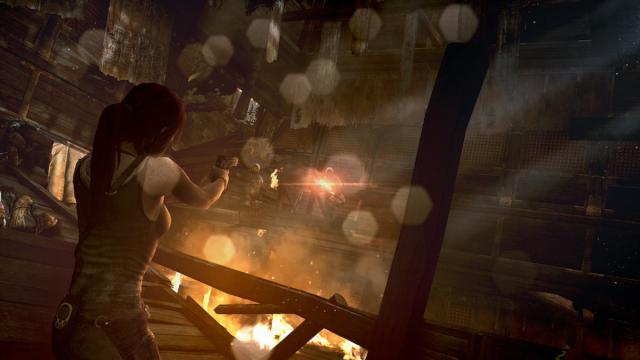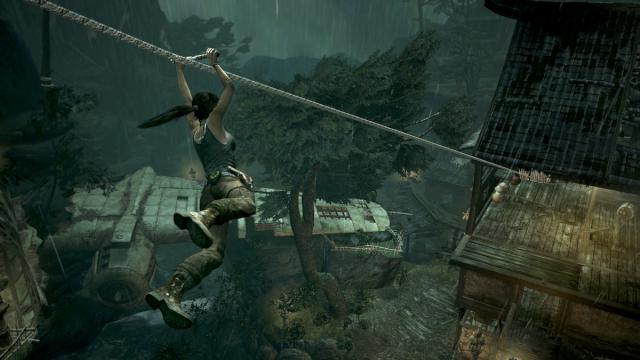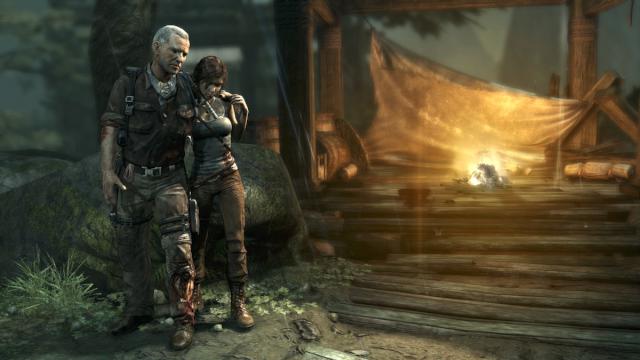
Those of us old enough to remember the console wars between the Sega Saturn and the original Playstation have very fond memories of Tomb Raider. Released in 1996, it created a huge digital icon in Lara Croft, and, while a lot of media attention was focused on the size of her pointy breasts, it was impossible to ignore the fact that it really was a ground-breaking step forward in gaming. The mixture of action and puzzle solving in massive open environments meant that the original really was something special. Inevitable sequels followed, without too many fresh innovations, right up to Tomb Raider: Underworld in 2008. It’s impressive that, apart from 2003’s awful Angel of Darkness, the quality of the games has always been high. Unfortunately, time moved on and Tomb Raider began to look dated, especially when Naughty Dog’s Uncharted games showed what action adventure should look like.
Crystal Dynamics have been Tomb Raider’s developers since 2006 and they are more than aware of the challenge of bringing Lara Croft up to date. It’s been five years since Underworld and in the meantime they have taken Tomb Raider right back to the drawing board and gone for a complete reboot, giving Lara a new origin story and rebuilding all the game mechanics from scratch. But has it worked? Has new Lara got what it takes to compete with the best new games, or is she still just a pretty gaming dinosaur?

The game opens with a frenzied series of prologue levels. Lara is out on her first big adventure, a naïve but enthusiastic teenager off to see a mysterious island with a group of far more experienced explorer friends. Before you know it their boat is destroyed and Lara is washed up on shore all alone. Her friends are missing and she’s been captured by the island’s resident tribe of mad-god worshipping psychos. It’s a head rush of running, climbing, wriggling, and scraping to safety, which teaches you the basic controls, without it feeling like a chore, while getting you completely immersed in the action from the word go.
The tone of this game is a lot darker than previous outings. There is a lot more gruesome survival horror based on an inexperienced young girl fighting for her life against homicidal maniacs. You get waves of deranged cult members, caves full of mangled corpses and some very weird and creepy quirks of the environment. The island, under the power of vengeful Japanese Sun Goddess Himiko, is a character in its own right. Once you’re wrecked there you can’t leave. Everything is topsy-turvy with random weather changes and strange shifts from day to night that add to the nightmarish quality.
The island environment is huge and Lara is allowed a lot of freedom to roam and explore, collecting various salvage, documents, relics and so on, as well as puzzling out the challenges required to get from A to B. The L2 button also helpfully points you back to the right path if you’ve let yourself get distracted for a while. Some of the environments really are breathtaking, with fantastic set pieces in a wind-torn temple, a cliff-top village and a battle on rusty cable cars being just a handful of highlights. There are also sections that trigger Uncharted style action sequences that cause frantic dodging and button bashing as Lara tumbles down ravines or leaps across collapsing ledges. On the whole these work well and add welcome changes of pace and excitement, although the reaction time on some is very tight and being repeatedly splattered on rocks or skewered through the neck can become a bit frustrating.

Controlling Lara is very intuitive, whether it is the simple mechanics of moving around or selecting weapons and equipment. As Lara’s abilities improve additional functions are added but it never becomes awkward or fiddly. It is also recognisably similar to control systems from the earlier games, which is comfortable for Tomb Raider veterans, and the combat, never a series strong point, is the best it has ever been.
The save system is fair with regular automatic save points as you progress, but there are also player selected ‘base camp’ locations where you can stop and improve Lara’s abilities. As Lara completes episodes she gains experience points which can be used to upgrade her combat and survival abilities. Any salvage she collects can be exchanged for weapons and equipment upgrades. As the difficulty increases so does Lara’s resilience but upgrades are limited and the choices you make will affect your ability to cope with different challenges. This system also encourages a non-linear approach to the game as the upgraded Lara will suddenly be able to access areas of the map that had been off limits, or tackle puzzles that couldn’t be solved earlier. The satisfaction of being able to go back armed with new skills is a nice pay-off for the frustration of not being able to complete things first time round.
The main game lasts around 20-25 hours but Tomb Raider offers a lot of return value. There is an Assassin’s Creed style fast travel system which lets you jump between base camps. Lara gains maps along the way which show the locations of treasures, salvage, clues, secret tombs and so on, and bagging the lot will significantly extend the game’s lifespan.

This Tomb Raider is a definite evolution for the series and a great starting point for reviving Lara Croft. It looks absolutely gorgeous with fabulously detailed environments and character models. The game design is addictive and immersive fun, continually leading Lara on to the next challenge, and, because you always feel like you’ve got something to do, sitting down for a quick blast can quickly lead to a few hours whizzing by in a flash. Crystal Dynamics have integrated many elements from the very best current games into a tired old formula and made Tomb Raider fresh and exciting again without losing some of the features that made the series great in the first place.
Until now Tomb Raider has always been a solo gaming experience, but some multi-player features have been added here. There are the usual predictable options; Team Deathmatch, Capture the Flag, Survivor, and so on. They work well enough and there are more downloadable maps on the way. You can see why developers want to add to the appeal and longevity of games with multi-player content but, while serviceable enough, this isn’t anything very special or original. It’s hard to imagine that many players are going to let it distract them from the main draw of the single player version for very long.
As great as Tomb Raider is, there’s a ‘but’. For a game called Tomb Raider there isn’t a lot of raiding tombs going on. There are certainly secret tombs hidden all across the island, each with puzzles to solve and rewards waiting to be discovered, but they tend to be small in scale. There’s certainly nothing here to match the vertigo inducing complexity of St Francis’ Folly from the original, or the octopus room from Underworld, which may be a disappointment for some long term fans of the series. All in all though, this is something very much worth getting your hands on.
Reviewed on PS3


Picked this up this week, on offer at Game for
Will have to give this a go at some point. I too loved the old Tomb Raider games, but love me some action too. 🙂
Just finished it, it was one hell of a rush! Brilliant game, a bit too shooty but still brilliant.
Looking forward to trying this out as well, everyone is saying how ace it is I’d be a bit stupid not to…